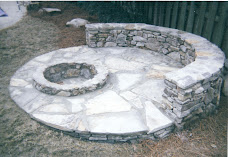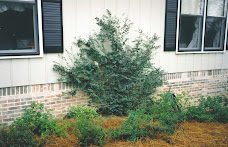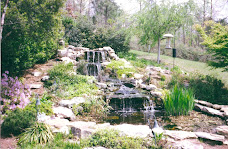
One way to add to your curb appeal is to make an improvement to one of the first things a visitor sees when they happen upon your humble abode. The mail box!
This is a stone mail box I built a couple of months ago, South of Birmingham, AL. Aside from ditching the rotting wooden post that was the structure for the faded, black box, I also moved the location of the mail box to be more convenient for the homeowners. And, while yes, most of the new metal box is hidden behind stone, the homeowners and I agreed that an upgrade there was in order. The new box is larger than the old one and has a nice copper finish to it that was a nice compliment to the stone. Finally, the day after the finishing touches were done, I hid in some nearby bushes and watched as the postman delivered the mail. Yes! The mail was delivered successfuly and I was able to move on, with confidence, to the next job.
Saturday, December 3, 2011
You've Got Mail ! - Brown Stone Mail Box
Posted by
themanfromearth
at
9:52 PM
0
comments
![]()
Labels: stone mail box, stone work
Monday, October 31, 2011
A Place to Hang : Brown stack stone wall with firepit, stone benches, and crushed ore patio.
Posted by
themanfromearth
at
10:28 AM
1 comments
![]()
Labels: bench seating, fire pit, patios and walkways, project showcases, stone work, walls
Tuesday, June 7, 2011
Sometimes Stepping Stones Won't Do

The space between the parking area and the back yard of this Vestavia home is well traveled by adults, children and grand children,,,and me. For years, I had done work in this yard, often inadvertently pushing around the stepping stones that were sitting in the underlying muddy terrain. Then one day it dawned on me. These folks need a solid, mortared walkway! Now, they're happy, their children and grand children are happy, and, I'm happy. Yeah!
Posted by
themanfromearth
at
12:05 AM
0
comments
![]()
Labels: patios and walkways, stone work, video clips
Tuesday, March 8, 2011
Small implementations can make a big difference

A small amount of stone (around 1 ton) was used on this particular project. The two stack stone walls are barely one foot tall, yet they significantly helped improve the overall appeal of this front yard.
Also, the sloping terrain was negated somewhat and a couple of planting spots were created where roots from nearby trees were making digging a bit of a chore, before.
In my opinion, bold statements can sometimes be made without commiting to a huge undertaking. 
Posted by
themanfromearth
at
12:55 AM
0
comments
![]()
Labels: stone work, walls
Monday, March 7, 2011
Milk Can Water Feature
 This recent project involved using an old milk can that the homeowner had and incorporating it into a small water feature. The pond was placed on top of the patio, leaving the smallish, but quaint yard for plants and paths. A 'Bloodgood' Japanese maple was planted near the pond to provide a little shade and offer some interesting reflections on the water surface. A special shout out goes to Bella (featured in the video) and Dolce for their superb company.
This recent project involved using an old milk can that the homeowner had and incorporating it into a small water feature. The pond was placed on top of the patio, leaving the smallish, but quaint yard for plants and paths. A 'Bloodgood' Japanese maple was planted near the pond to provide a little shade and offer some interesting reflections on the water surface. A special shout out goes to Bella (featured in the video) and Dolce for their superb company.
Posted by
themanfromearth
at
10:18 PM
2
comments
![]()
Labels: ponds, stone work, video clips
Saturday, March 5, 2011
Kitchen Window Fun!
One reason I enjoy this time of the year is because that call to do a little fruit tree pruning will typically come in. What's fun about pruning fruit trees? Well, you've got a point there, but the side benefit is that you've got clippings that can be brought indoors to eventually bloom into quite a nice bouquet. Fruit trees, from my experience, are best, but you might have success with other flowering plants such as flowering quince, forsythia, and jasmine. Take a few stems as the flower buds appear to be beginning to swell and put them in a vase of water. Sit the vase in a window and enjoy! Experiment with different plants (what about azaleas or roses) and let me know if you're having success! 
Photo Right: This grouping of peach tree stems didn't show any color at all a week ago.
Posted by
themanfromearth
at
10:43 PM
0
comments
![]()
Labels: landscape tip, pruning, Rob's musings
Sunday, October 17, 2010
A Foundation Planting that is Mindful of Erosion, Allergies, and Spacing

My most recent landscape excursion involved the installation of a front foundation planting in Hoover, AL. The home owners brought up a few concerns as we began talking about their landscape. For one, they had been battling some erosion issues at the sloping end of their home by the drive way. Also, there being issues with allergies in the family, plants for the landscape needed to be chosen to address those needs. Finally, the homeowners talked about wanting a landscape that wouldn’t become overwhelming for them. I was excited that they were aware that spacing plants too closely, while looking great initially, would eventually bring on pruning headaches and make the landscape seem like one giant hedge rather than a thoughtful gathering of distinguishable plants. PHOTO LEFT: Son, Jake, helps his dad with stone wall installation.
PHOTO LEFT: Son, Jake, helps his dad with stone wall installation.
A brown stone wall was installed to negate the sloping portion of the front foundation. The wall, about 4’ tall at the drive, flows into what becomes a stone border for the entire foundation planting. The wall and stone border follows lines that are curved to help include a couple of small trees and some plant depth within the planting area. Also, a small stone bench is placed on the level side of the foundation for interest and also to add a little extra “weight” to help counter the stone wall on the sloping side of the house.
Choosing plants that are relatively allergy free required a bit of research. I was aware that plants with leaves that are heavily pubescent would be more prone to trigger an allergic reaction, so that was my starting point as I developed a plant list. I also used the book, “Allergy-Free Gardening”, by Thomas Leo Ogren. Mr. Ogren uses a 1 to 10 rating system to classify a plant’s allergy potential. Every plant used in this landscape was rated 1 (best) to 5, with most being rated 3 or better. The plant list:
(from left to right as you look at the house from the street)
1. Variegated Pittosporum
2. Bloodgood Japanese maple
3. Autumn fern
4. Shi-Shi Gashira Camellia
5. Harbor Dwarf Nandina
6. Snow Indian Hawthorne
7. George Tabor Azalea
8. Tonto Crape Myrtle
9. Sherwood Abelia
10. Pansies (probably Begonias in the Spring)
Spacing of the plants in this landscape was generous. Aside from avoiding a crowded landscape in the future, a well spaced landscape also encourages good air circulation between plants which is very helpful in promoting good plant health. Another feature of this landscape was the installation of landscape cloth. Landscape cloth is similar to landscape fabric, but better. No cloth or fabric is 100 percent effective, but it can typically cut down on about 95%, or more, of your weed problems during the first 5+ years of the life of a landscape and that is when you really need that kind of weed control.
It was enjoyable working on this project...The weather was great, all aspects of the job were fun, and working for the home owners was really a pleasure.
Posted by
themanfromearth
at
10:29 PM
2
comments
![]()
Labels: bench seating, project showcases, stone work, walls







































